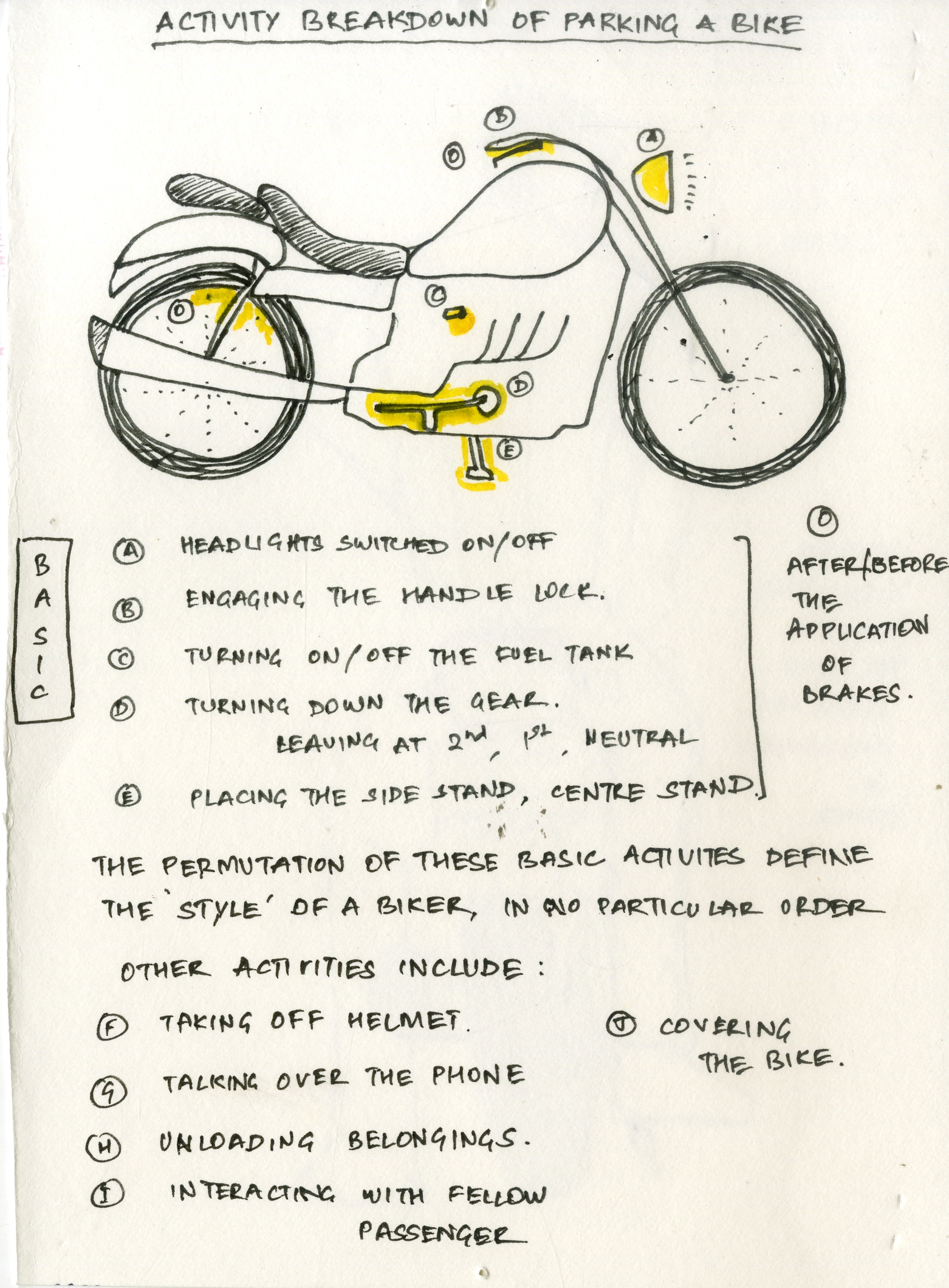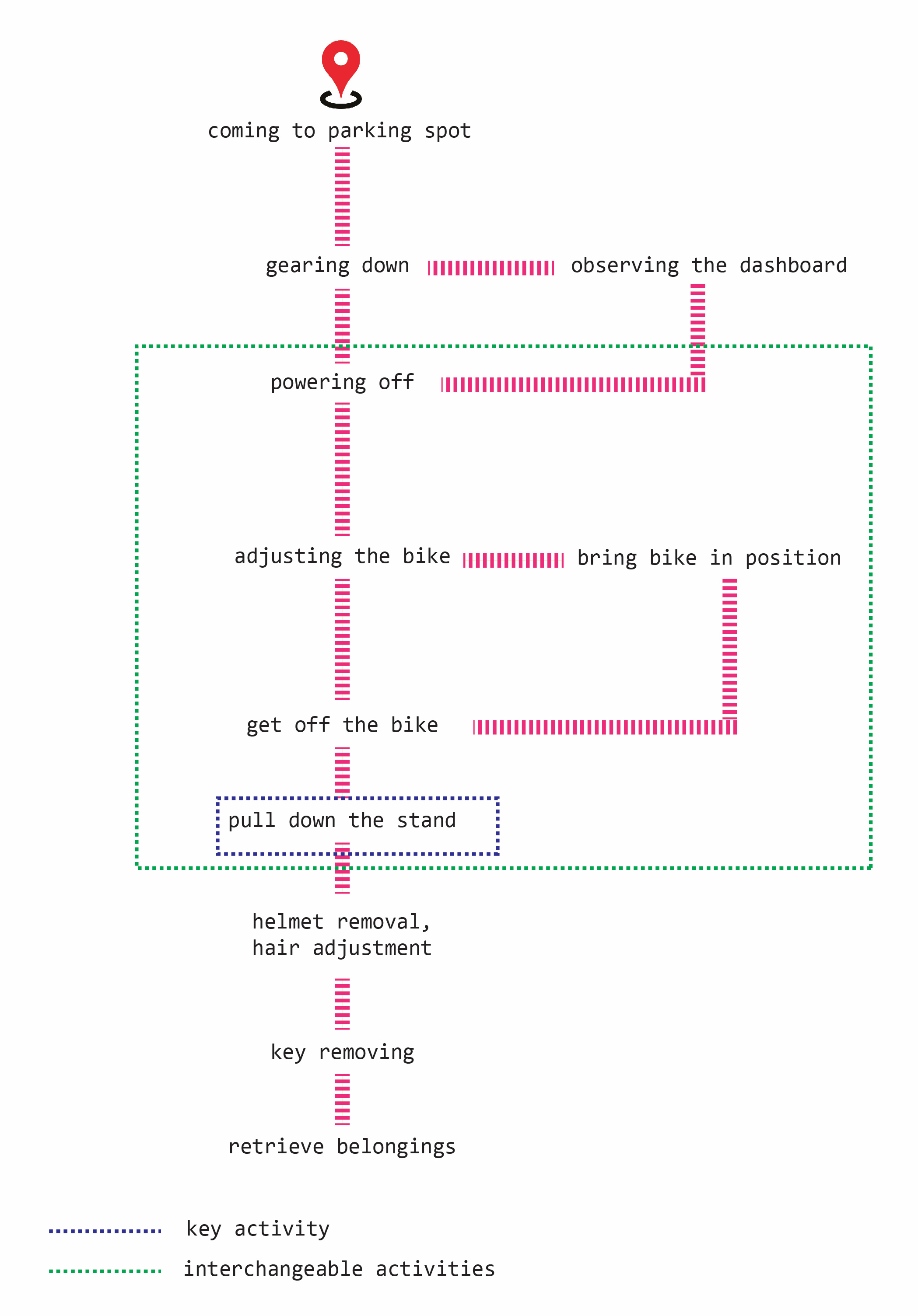The following project is an output of a 2-week module Design Process. The objectives of this module was to get an introduction to the different stages of design process – from perception of a problem to generating solutions, through investigation, analysis and synthesis and learn the methodology of any problem solving process. The module gave us an overview of the process of design, so that we can apply our learnings in our respective domains under appropriate conditions.
For our activity selection, we chose Parking of 2-wheelers in NID Gandhinagar campus. Our process started with observing a variety of parking spaces in as well as outside campus. On-campus spaces included main parking area near front gate, parking area between the two hostels and some undesignated parking places. Outside the campus we looked at parking spots in nearby markets like Pramukh Arcade and InfoCity. On subsequent team discussions, we arrived at numerous revelations and initial observations which were accompanied by many questions. Our questions led us to analyse our hypotheses that were driven by data collected from observations and user interviews.
Breaking the task into simple activities and then into sub-activities, while maintaining a close eye on each activity, we documented the process and further key-observations helped us understand where the opportunity for improvement lies, define our problem statements and suggest ideations.
Our observations led us to working out tangible as well as intangible ideas. The range of ideations cover various fields of study like space management, light and colour psychology, behavioural psychology, human-computer interaction, ergonomics and physiology.
Overview
Space management ideas deal with proper arrangement, alignment and placement of construction components in parking area. This includes the placement of pillars/poles, the arrangement of parking lines, the gutter space between 2 lines of parking, the placement of sign boards and posters, the arrangement of the negative space and placement of landscaping elements like bushes, trees, etc.
When we talk about light and colour psychology we try to answer the question like how should the ambient lighting and focused lighting of the parking lot be, what is the optimum brightness required, where the sources of light should be placed, how technology can enable efficient use of light resources. Furthermore, what should be the mood of parking space and how the coloured lights and signage affect the psychology of the user?
Behavioural psychology of the process includes studying the preferences, likes and dislikes of the users and mapping them to their interactions with the parking space.
Apart from these, we studied the effects of parking on the human body (physiology), the ergonomics (shape, placement and usage) of various bike components and how the incorporation of technology will affect the interaction between user devices and vehicles.
Activity Brief & Current Scenario
The campus observes a peak 2-wheeler traffic of 82-89 between 9:00 am - 5:00 pm and least number of bikes between 02:30 am - 7:00 am. The administration has allotted two places for parking, one at the main gate and the other at the hostel area. It was found that parking at the entrance is much organised compared to hostel area parking.
Main gate parking is a planned parking with infrastructure and the hostel parking was allotted based on the need. Main gate parking is well lit during the night, which the hostel area parking lacks. It was found that the Main gate parking area is majorly used by the staff and faculty during work hours and hostel area parking is used by the residents of the hostels. The campus has two gates, the main gate gives access for the for the entry and exit of the vehicles.
Parking spots in the NID Gandhinagar campus
Vehicle-wise accessible locations
Proximity based preferred parking spots
Parking timeline and traffic observed from 3 - 5 Oct 2017
Observations
A. BREAKDOWN OF PARKING A BIKE
Most of the riders in the campus were either fairly adept in riding/parking a bike or did not know how to ride one. It was hence, paramount for the team to get familiarised with the process.
Mounting and dismounting a bike is so fluid and wired for so many of us riders that we hardly pay attention to the whole act. We hoped that dissecting the whole process will give us some useful insights. After watching many riders and performing the action ourself in front of a slow-motion camera, we were able to propose a basic flowchart that we believe everyone follows when parking his/her bike.
We looked for nuances such as foot movement, body inclination, bike tilt, average parking time, etc.
B. BODY MOVEMENTS AND BIKE TILT
One interesting observation was the 'tilt angle' of a bike and a biker while dismounting from a bike. The angle might depend on many factors like built of the bike and the biker, the weight of the bike, the space available for parking and the relative position of the side-stand.
C. SIDE STAND AND CENTRE STAND
The stand plays an important role in parking a bike (duh!). But, whats interesting is that there are two types of stands available in modern day bikes. The centre stand grabbed our attention as it was least used, even though it provided more stability while parking. We also noticed that many folks tried to engage the centre stand while sitting on the bike. Refer figures below:
D. JOINT STRESS AND PRESSURE POINTS
The pressure experienced by the muscles while twisting the knees and the ankles might be very mild but becomes a key factor when keeping elderly and physically disabled in mind.Though we did not dive deep in this category, here are some diagrams to explain the phenomenon:
Key Observations and Analysis
On collection of data via general observations and personal interviews based on the questionnaire below, we gathered following key observations and made following analysis which were part intuitive, part data-driven.
Further observations...
- Few people leave their helmet on their bike unattended.
- Few people have problems removing keys off their bike.
- Many people do not turn off their headlights.
- There are no visual guidance for parking of 2 - wheelers in campus.
- People tend to do quick parking if work duration is short.
Opportunity mapping
Defining the prospects of improvement and their finer categorization was the main aim of this stage. Opportunities might be tangible or intangible in nature.
- Space management for organised parking
- Protection of vehicle from natural elements
- Surface enhancement of parking areas
- Awareness regarding centre stand and its usage
- Addressing the sense of insecurity in bikers
- Improving visibility around the parking area
Problem statements
- Designing/planning of space which addresses biker’s priorities, thus making the parking area more organised.
- Structural development of parking area so that it provides protection to the vehicle from the damage caused by natural elements.
- Addressing the rough experience of steps and uneven surface of parking area compromises duration of parking and stability of the bike while and after parking.
- Providing guidance to the biker who wants to park the vehicle with the centre stand but feels incapable.
- To provide visual/non - visual feedback to the biker who is concerned about constant security and safety of the bike.
- Implementation of visual communication between biker and parking area during dark situations (cloudy/night) for faster and easier parking.
Ideations
Serving as the final stage of our course, this phase dealt with idea generation and gentle attention to the cost, feasibility or the complexity of the solution. Here are some ideas we presented:
1. Designing/planning of space which addresses biker’s priorities, thus making the parking area more organised
Distributing the parking space with concrete bumps
Distributing the parking space with reflective stickers
2. Structural development of parking area so that it provides protection to the vehicle from the damage caused by natural elements
(Top) Sunlight movement in the parking area between the hostels
(Right) Automatic movable screen based on sunlight, also uses solar panels to charge parking lights at night
Foldable shed attached to the hostel walls
3. Addressing the rough experience of steps and uneven surface of parking area compromises duration of parking and stability of the bike while and after parking
Current situation: circular - wooden planks are placed at the entry points of the parking area, which gets displaced often.
Suggestion: Fixed/concrete inclined at the entry points of the parking area.
Filling the dents to improve vehicle stability
4. Providing guidance to the biker who wants to park the vehicle with the centre stand but feels incapable
Automatic centre stand system
Surface graffiti to enable centre stand
Voice instruction unit for centre stand with locking mechanism
5. To provide visual/non-visual feedback to the biker who is concerned about constant security and safety of the bike
Live monitoring system of the parking area anywhere from the campus
IR - laser based alarm system with smartphone notifications and alarms
6. Implementation of visual communication between biker and parking area during dark situations (cloudy/night) for faster and easier parking
Reflective stickers to guide bikers during dark situations
Flood lights to increase visibility during night
Learnings
- To be able to find a solution for any problem or to find any design intervention it’s very important to observe the activity and people involved in each aspect of it.
- The activity is generally further divisible into further sub - activities. While observation phase, the activity breakdown into sub activities and to look upon them with an outsider view is of utmost importance.
- To analyse the activity properly various parameters such as time taken, measurements, area of space, count of people, people’s emotions and ease should be taken in record and gather as much data as possible.
- The analysis of the gathered data in terms of percentages helps to pick up key observations from found the observations by comparing the differences and thus aids to find the opportunities for improvement easier.













